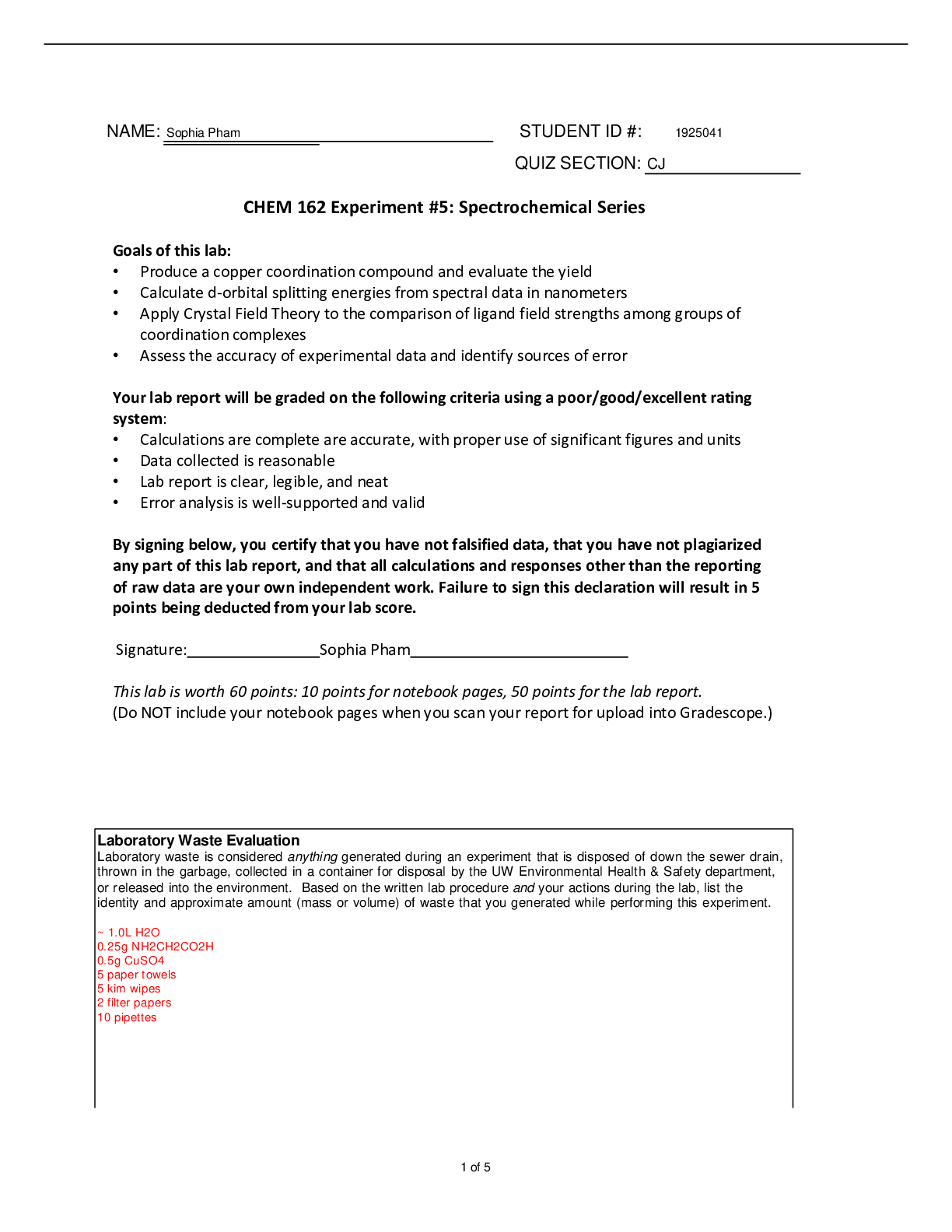Biology > Lab Report > PHYSIOLOGY OF FROG SKELETAL MUSCLE University of Iowa - BIOL 1412lab report 2 FROG LEG (All)
PHYSIOLOGY OF FROG SKELETAL MUSCLE University of Iowa - BIOL 1412lab report 2 FROG LEG
Document Content and Description Below
PHYSIOLOGY OF FROG SKELETAL MUSCLE Natalie Rapp Sandra Castillo, Yvette Manzanares, & Trey Mueller Pairs 1 and 2 BIOL:1412:A03 April 10, 2018Introduction The most abundant tissue in the anima... l body is muscle tissue, which produces force and movement. One type of muscle tissue primarily attached to the animal’s bones is called skeletal muscle; these are the muscles that contribute to locomotion and other body movements. Skeletal muscle cells, known as muscle fibers, are large, multinucleated cells that form through the fusion of many myoblasts, or individual embryonic muscle cells (Sadava et al., 2012). Muscle fibers contain numerous myofibrils, which are the ordered assemblages of thick myosin and thin actin filaments. Muscle contraction is due to the interaction of these long filaments of proteins. Muscle fibers surrounded by layers of connective tissue form skeletal muscles which are attached to the bones by bundles of collagen fibers called tendons (Sadava et al., 2012). The arrangement of actin and myosin filaments give skeletal muscle a striated appearance. The myofibril contains repeating units called sarcomeres which are made up of overlapping actin and myosin (Sadava et al., 2012). This overlap creates the striped appearance of skeletal muscle. Each sarcomere is bounded by Z lines that anchor the thin actin filaments and in the middle of the sarcomere is the myosin filaments, known as the A band (Sadava et al., 2012). A protein called titin holds the bundles of myosin filaments to the Z lines within the sarcomere; titin molecules are elastic, allowing the myosin filaments to slide over the actin filaments when a muscle contracts (Sadava et al., 2012). During contraction, the sarcomeres shorten, resulting in a changed banding pattern which can be seen under a microscope (Sadava et al., 2012). This mechanism of muscle contraction is known as the sliding filament model. 1Contraction of a muscle is triggered by the firing of an action potential by a motor neuron in the somatic nervous system. A motor neuron’s axon terminal is highly branched and connects with hundreds of muscle fibers creating a motor unit, allowing for simultaneous contraction of the fibers when the neuron fires an action potential (Sadava et al., 2012). Muscles can consist of multiple motor units, therefore, in order to increase the strength of contraction the motor neuron firing rate can be increased or more motor neurons can be recruited (Sadava et al., 2012). When motor neuron’s action potential reaches the neuromuscular junction - the gap between a neuron and skeletal muscle - it causes the axon terminal to become depolarized (Sadava et al., 2012). This depolarization causes the release of a neurotransmitter called acetylcholine (ACh) which goes into the synaptic cleft between the muscle and the neuron and binds to receptors in the postsynaptic membrane (Sadava et al., 2012). This causes the muscle fiber to fire an action potential that flows along the plasma membrane and into its tubular invaginations called T tubules that lie adjacent to the sarcoplasmic reticulum (SR) (Sadava et al., 2012). The SR is a network of compartments that store calcium ions and when the action potential passes through the T tubules, calcium is released by the SR into the cytosol where it diffuses through the sarcomeres’ cytoplasm (Sadava et al., 2012). Within the sarcomere, actin filaments hold two proteins: troponin and tropomyosin, and the myosin filaments have round heads that are bound to molecules of ADP and inorganic phosphate (Pi) (Sadava et al., 2012). When the calcium ions reach the sarcomere, they bind to troponin which then changes conformation and pulls the tropomyosin aside, exposing a myosin-binding site on the actin filament (Sadava et al., 2012). The myosin heads bind to the actin, creating a cross-bridge and allowing for the release of ADP and Pi which forces the myosin heads to pivot inducing the 2filaments to slide past each other in a power stroke; the myosin must bind to ATP to disconnect from the actin from which myosin hydrolyzes ATP, initiating another cycle of a power stroke (Sadava et al., 2012). Calcium pumps in the SR are then activated and remove the Ca2+ ions from the sarcoplasm, changing the conformation of the tropomyosin back to its state of blocking the actin-myosin binding sites, and the muscle relaxes (Sadava et al., 2012). [Show More]
Last updated: 2 years ago
Preview 1 out of 18 pages

Buy this document to get the full access instantly
Instant Download Access after purchase
Buy NowInstant download
We Accept:

Reviews( 0 )
$9.00
Can't find what you want? Try our AI powered Search
Document information
Connected school, study & course
About the document
Uploaded On
Apr 19, 2021
Number of pages
18
Written in
Additional information
This document has been written for:
Uploaded
Apr 19, 2021
Downloads
0
Views
67




.png)









